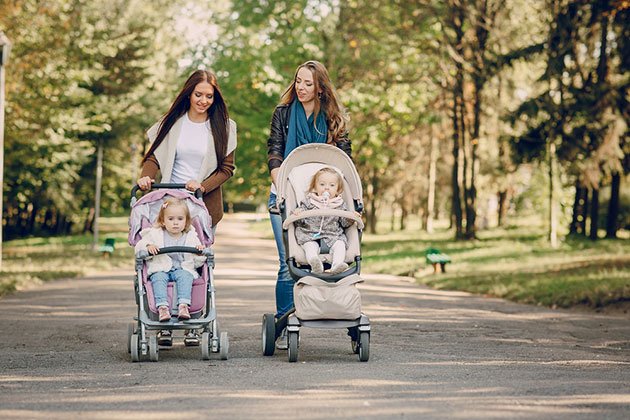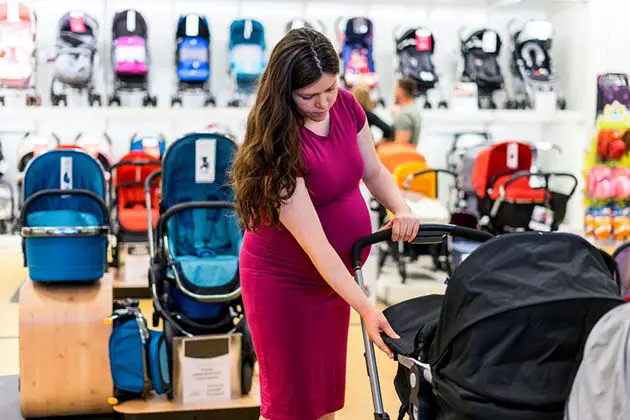Strollers and prams are a necessary purchase for every active parent. Daily walks require you to pick something that is lightweight, easy to use, and comfortable for your newborn.
But, how exactly are pram and stroller different, other than the age limit?
Whether you are a newbie parent, or a proud aunt looking to surprise her new nephew with a city stroller or a pram, this list will help you learn the differences and advantages of both models.
More...
Comparison of Pram vs Stroller: The Summary Table
Criteria | Stroller | Pram |
|---|---|---|
Style | Features a chair-like style on wheels that allows the seat to recline in multiple positions. | Features a bassinet style that allows only for a lie-flat position. |
Age Limit | Suitable for babies older than six months that need to sit upright. | Suitable for infants under six months who require a reclined position. |
Maneuverability | It can be found in a lightweight design that is suitable for city walks. | Heavier and tricky to maneuver, especially on uneven terrain. |
Benefits of Use | It can be used throughout the growing period. | Only suitable for younger babies under six months. |
Safety System | Includes a 5-point harness. | Does not include a harness or a safety belt. |
Cost | Pricy | Cost-effective |
What is a baby pram?

A baby pram is a traditional baby carriage that ensures a flat sleeping surface, suitable for infants only.
The first couple of months are critical for the optimal development of a baby, so you should pay attention to the riding positions. A reclined lie-flat position helps the infant develop the spine, hips and ensures healthy breathing.
One of the benefits of using a pram is getting many of your daily tasks done during your baby's nap time! It's perfect for busy, multitasking moms!
Since prams include a carrycot with a large canopy, they are great for offering your baby the sun protection it needs.
Additionally, most models will consist of ample storage space underneath so you can fit all of your necessities.
- Features a unique design, available in several baby carriage color options and fabric materials.
- Necessary for newborns
- Includes a large sun canopy
- Large storage basket
- Roomy baby carriage for comfortable naps
- Not suitable for an older child
- Often tricky when turning corners
- Three-wheeled prams are prone to tipping backward
- Small wheels
- It cannot fit in the car boot
- Not foldable
- Heavy
- Lack of safety belts and harness
What is a baby stroller?
The baby stroller resembles a chair-like seat on wheels. With the upright seat design, the stroller is a convenient baby transport solution for babies over six months old.
But here is the most significant benefit:
Strollers are available in various models, which you can choose based on your lifestyle.
With that in mind, you can opt for a jogger stroller, twin strollers, double stroller, convertible bike stroller, and other lightweight stroller options that are even suitable for public transport, such as a travel system!
Strollers are known for their easy maneuverability on rough ground. You can find models with sturdy stroller frames and larger wheels that fit that purpose.
Although most are unsuitable for a newborn baby, many convertible stroller models offer several reclining seat positions for comfortable naps.
Such is the Maxi-Cosi Zelia 5-In-1 Modular Travel System, which provides a layback stroller design and is the best choice in travel systems.
- Suitable for babies and toddlers
- Compatible with baby car seats
- Ample storage space
- Foldable for easier traveling
- Often includes a reversible handle
- Large wheels make it easy to maneuver
- Adjustable backrest
- Often consists of a five-point harness
- Some models have a front bar for snacks
- Not suitable for newborn babies
- Expensive
- The majority of stroller frame designs will require an adapter
- Twin strollers are tricker to manoeuver
Stroller vs. Pram: What Are the Differences?
1. Age Limit
Pram
A pram is only suitable for the first couple of months of babies life.
We mentioned that a pram resembles a carrycot design on wheels. With that, you should note the flat sleeping position is only suitable for infants ages 0-6 months.
After that, a baby needs to accustom to a reclined position and eventually accommodate an upright seat.
Stroller
Although many stroller designs are on the market, most are unsuitable for newborn babies. Strollers should be used when the baby is over six months old, as it needs an upright seat.
However, you can also combine an infant car seat with many strollers and take your little one for a short walk.
Even though you can not use them for longer naps before the baby turns six months of age, they are still an excellent option for quick trips.
2. Design

Pram
A pram is known for its cumbersome design.
Unlike strollers, they are not lightweight and compact due to the large carrycot or bassinet. It often cannot pass through tight aisles and is tricky to maneuver.
Prams are carefully designed to fit the comfort and safety of the infant with the reclined seat and a wheeled frame.
One of the greatest benefits that a pram offers is the large sun canopy on the baby carrier. It covers the baby from harmful UV rays while keeping them shaded for a cool and comfortable nap.
You can also purchase the footmuff or a rain cover that protects the baby during cold and wet weather.
Most traditional prams offer a large storage basket underneath the carrycot so you can easily fit your daily baby necessities.
Stroller
Strollers are designed with big wheels that allow for better maneuverability on rough terrain and city walks.
The most significant difference between a pram and a stroller design-vise is that the stroller is a far better option for traveling.
Thanks to the foldable design and lightweight frame, many strollers proved trustworthy companions for family travel.
But, that's not the only benefit:
Strollers usually include a snack tray for the child and a parent tray near the handles. A child tray is an excellent addition to every stroller design, as it holds the sippy cup, a snack, or even your child's favorite rattle toy.
3. Weight
Pram
Prams are known for their heavy-weight design. Usually, a pram will weigh between 20-40 pounds, depending on the carrycot size.
Additionally, many prams are not suitable for traveling, as they are not foldable.
Stroller
Prams and strollers also differ drastically in the weight department.
The stroller seat is a lot lighter than the pram seat. You can find lightweight strollers at only 10 lbs which are great for traveling and shopping around the city.
Twin and double strollers can get a bit heavier, but if you plan on using the traditional single stroller, you won't have to stress over the weight. With that in mind, umbrella strollers are the lightest of all stroller models.
4. Safety System
Pram
A pram and stroller have a significant safety difference.
For instance, prams lack safety belts and harnesses. Therefore, you should never leave your baby unattended, even during nap time in prams.
Stroller
The safety belts and harness are the primary addition to every stroller.
They are designed to protect babies and toddlers by keeping them properly restrained in their stroller seats. You can find a stroller with a 2-point, 3-point, and 5-point harness.
Along with the chest harness, the safety system is equipped with a crotch strap and a waist strap.
You will get a parking brake with many convertible strollers and jogger strollers. This allows for controlled walks, especially if you are walking on a rocky road.
Pushchair vs. Stroller
Pushchair or stroller is often compared to one another, making every parent wonder: Are they the same thing?
Although a pushchair is similar to a stroller, they share some differences in use and design.
For instance, a pushchair is often suitable to use from birth to toddler age. In addition, due to their infant accommodation, a pushchair offers many long-term benefits for parents.
Additionally, they are an excellent travel buddy! They fold easily, fit into any car trunk, and have a lot of parent-friendly features.
Compared to a stroller, a pushchair is made to last a lot longer.
Carriage vs. Pram
When it comes to carriages and prams, there are no differences.
These are the terms related to the same type of four-wheeled device used to carry infants in a reclined flat position.
Buggy 101: Is It Any Different From a Pushchair?
A buggy is a world-facing riding device that resembles a pushchair.
If you want a travel-friendly option for your toddler, then a buggy is the way to go!
Compared to a stroller and a pushchair, a buggy is far less expensive, offers support as the baby grows, but it is also less durable.
FAQs
Why is a stroller called a pram?
The stroller is used as a US term, while a pram is primarily used in British English.
However, these two common terms do not refer to the same baby device. While a pram is meant to carry infants, a stroller is suitable only for babies older than six months.
What is the purpose of a pram?
The purpose of a pram is to safely carry infants up to six months in a flat position.
Newborns require this position for optimal spine, hips, and breathing development in the first couple of months.
When the baby is lying flat, the purpose of a pram is to keep the breathing unrestricted and offer appropriate oxygen saturation.
Which is better, stroller or pram?

A pram is better for infants that require a flat sleeping position during the first six-month period. A stroller is best for older kids and toddlers who can sit up unassisted.
Note that you cannot use a stroller with newborns as it will compromise the development of the breathing organs and the spine and hips.
What do you call a baby pushchair?
A baby pushchair is often called a stroller as well. It resembles a stroller's design but is a less expensive and more travel-friendly alternative.
What is another word for a stroller?
The stroller has a variety of synonyms and is often referred to as a baby cart, buggy, pushchair, pram, or carriage.
However, the stroller is often mistaken for these synonyms as they all serve different purposes, ages, and have different designs.
What do they call a pram in America?
Pram, a British term, is called in America a stroller.
The term is short for perambulator, which means "one who perambulates or walks." It gained its initial meaning as a baby carriage in the 1850s.
What is the difference between a pushchair buggy and a pram?
A pushchair buggy is a foldable stroller-like design suitable for older babies. A pram is used mainly for newborns who cannot hold their head and neck unassisted.
However, if you need a travel-friendly design with parent and child comfort features, a pushchair is the best choice!
Final Words
Although these two terms are often mistaken, they do not refer to the same thing!
As you can see, prams and strollers have differences not only in design but in the age limit, weight and cost as well.
We hope we have cleared all your possible doubts on whether you should get carriage vs stroller.
Of course, both traditional prams and strollers have their pros and cons, but one thing is for sure:
whether a pram or stroller, choose carefully according to your budget, baby's age, and versatility needs.
